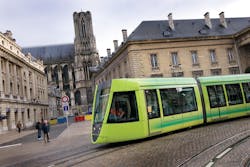Hybrid technology has been around now for over a decade, but as oil prices continue to rise and environmental pressures get stronger the market is growing and improving. Both the bus and rail sectors have seen advancements in technology that make hybrids more viable to transit agencies across North America.
One key to growing the market is volume and economies of scale, according to Mike Mekhiche, director of Products and Technology at BAE Systems. “I think the challenge is really the volumes. Economies of scale are really important to driving costs down and accelerating market acceptance of the product and technology in general,” he says. “We are at the point where, for example in the transit bus market, the volumes are sizeable, they are attractive, but they still are not high enough to get the costs down to where hybrid becomes the standard for transit bus propulsion system. It’s kind of a chicken and an egg thing, you want volumes to reduce cost, but you want a lower cost to increase volume and so that’s a dilemma people like us and other hybrid suppliers are faced with and that is why continuous investment by companies such as ours is critical to sustaining and maintaining the technology as we build volumes to a point where the volumes will drive costs down. That’s the economic reality.”
Bus Market
On the bus side of the transit market, advances in batteries and ultra capacitors are making hybrid buses more appealing. In North America, the market for hybrid buses is gaining strength and growing. “We see the market and consider the market very important for us,” says Thomas Orberger, business manager for Siemens HyrbiDrive in the Unites States. “Right now, we see very aggressive development, I’m talking now about the bus market, from let’s say conventional systems, diesel systems into areas like the CNG parts, which is not necessarily the technology that we promote, and electric systems.”
Orberger says there is a strong interest in electric systems in the form of hybrid buses. “We’ve participated in development for a couple of years later actually but we see strong activity and strong acceptance and activity in this market,” he says.
Battery vs. Ultra Capacitor
A big issue in hybrid bus systems is whether to go the battery route or the ultra capacitor route. While both provide electric power, they have some fundamental differences.” Both of them store energy, however, ultra capacitors store much less energy than a battery does when you look at per kilogram or per volume. But, what they do have is a much higher power density,” explains Chad Hall, vice president of sales and a co-founder at Ioxus.
Hall says no chemical reaction takes place when ultra capacitors charge and discharge, which gives them a long cycle life. Batteries, on the other hand, have what is called electro active material and every time they are charged and discharged, the electro active material begins to wear out. Therefore, the fast you charge and discharge a battery, the faster it will wear out.
“That’s the main difference; ultra capacitors are made to go millions of times, where batteries will typically cycle in the low thousands of times,” Hall explains. “There are batteries that are being used for buses, and they typically only use about 10 percent of the available energy in the battery pack so that they can do a high cycle life. There’s a ton of energy that’s wasted when they use a battery. With an ultra capacitor you discharge down to zero volts.”
Generally speaking, batteries require longer charge times. Ultra capacitors use breaking energy to recharge.
The upfront cost of ultra capacitors is slightly more expensive upfront than if you were to use acid lead batteries, Hall says, but the price is closer when compared to lithium ion batteries when it comes to the number of modules vs. the number of cells. Both batteries and capacitors require some sort of management system – either a battery management system or a module balancing system for the capacitors – making the electronics similar for both options, according to Hall.
However, the ultra capacitors are much more abuse tolerant, so higher temperature ranges, they’re not, they don’t catch fire or …much safer, they’re more recyclable. They’re 95 percent plus recyclable, and it’s very inexpensive to recycle the capacitors, typically about 35 cents per pound. When you look at batteries, lead acid batteries have been recycled for a number of years but they are only about 70 percent recyclable. And lithium ion batteries, there are a number of batteries out there that are used, but they just aren’t being recycled today.
Hall says in the last 10 years the cost of ultra capacitors has come down approximately 90 percent and at the same time performance has gone up five times. Battery costs have also come down and performance has gone up, however a bit more slowly. “You are getting about a five times better performing product at about 10 percent of the cost of what you would have gotten 10 years ago. In that same range battery performance has gone up maybe 10 percent and their price has only come down about 30 percent.”
Powertrain
Orberger says that globally, the United States has the highest penetration of alternative powertrains, more than Europe and more than China. He says the reason for this is because OEMS in Europe have optimized their transmissions and engines to gain fuel economy and reduce emissions over the last 10 years. “The reason for this is OEMs like Mercedes-Benz and other larger OEMs manufacture engines and transmissions, they have a vested interest, profit margins, the transmissions and engine.”
The difference in the United States is bus OEMS here don’t manufacture engines or transmissions, according to Orberger, so they don’t necessarily have a vested interest to change the powertrain and technologies used.
He says: “They are much more open to the depth and adjust to new technologies and to pass new technologies in order to save fuel and to reduce emissions and optimize fuel consumption. I’m a firm believer that this was the starting point here in the U.S., to adapt much earlier alternative powertrains and this is providing the U.S. and basically a jumpstart ahead of the Europeans. The Europeans right now they are trying to catch up. They are now embracing hybrid technology and time will tell how quickly the catch the U.S. “
According to Orberger, 50 percent of the attributed costs of a hybrid bus are energy storage and the 50 percents is the remaining equipment, motors, generators, etc. He says prices are coming down for bother energy storage and the other remaining equipment.
“What we at Siemens do, we have a global portfolio base so every order impacts on our supply chain, which has a positive impact on North America. If you have an order in China for 10,000 vehicles and we increase our economy of field, this is a direct impact on our cost base we have here in the United States to reduce our costs here as well. That’s one of the large benefits of a global organization like Siemens being active in this marketplace and every economy of scale has a global impact on this.”
He continues: “On the battery side, Siemens has decided to move and build our energy storage unit on ultra capacitors. That is part of our portfolio, so we have a direct impact and a direct control over our costs. It’s still expensive, but we have a handle on this and then the potential for Siemens to go into the battery packaging market.”
BAE Systems has been developing hybrid propulsion systems for 20 years, according to Mekhiche. BAE Systems’ HybriDrive series architecture is designed to support the needs of bus in an urban downtown area that is low speed and requires lot of stop and go operations.
“In a series system you no longer use the engine to drive the wheels. There’s a small engine that drives a generator, and the generator makes electric power and that electric power is then provided through wires to another electric machine that then spin the wheels. It’s all electrically driven,” Mekhiche says.
BAE Systems has demonstrated up to 40 percent fuel savings in the field with the series system. “So a hybrid bus that uses our hybrid series system would save on average 40 percent on fuel in service. Plus it gives you all the emissions reductions and quieter operation that you would need to meet the standards but also to enhance the environment in cities and crowded urban areas and so on,” explains Mekhiche.
About five years ago BAE Systems transitioned from a lead acid battery in their systems to a lithium ion technology based battery system. According to Mekhiche, the lithium ion-based system is a higher energy density technology, which means the weight of the battery itself is a lot lower, resulting in additional fuel savings. “It also supports longer range EV, electric vehicle, operation, shutting the engine off that is. We also introduced or looked at how the electric machine technology evolved we see a lot more use of current magnet technology based machines. Current magnet technology-based machines do give you higher efficiency than their counterpart, for example induction motors, they give you a lower weight and they’re easier to cool, and therefore they are simpler to integrate within the vehicle itself. That’s another trend with the technology itself,” he says.
While hybrid technology for buses continues to evolve and gain popularity, Orberger says hybrids are just a jumping point to full electric.
“We see the hybrids as this common understanding the hybrid platform is just a transitional technology to all electric transmission in the vehicles. What we’ve done at Siemens, we have always, at the end of the tunnel at the end of the horizon for Siemens is an all electric transmission for personal vehicles as well as bus, is the ultimate goal and we see the market is developing,” Orberger says.
Rail
On the rail side of the transit industry, there are a couple of different ways to look at hybrid technology. In some instances it could mean going from online catenary power to offline power using ultra capacitors or an in ground energy source, a technology that Alstom Transport has demonstrated. Hybrid rail can also be more of a dual power technology, using a diesel engine for part of the trip and then hooking up with electric power via catenary down the line, as Bombardier has demonstrated.
It’s Electric
Alstom Transport has had an offline service for nearly 10 years in place in Bordeaux called APS, which drove Alstom’s off wire developments. “That was specifically developed because the city of Bordeaux has an important historical city center they wanted to preserve so there were broad stretches of alignment where they were requiring no wires, which meant we had to go to a full autonomy solution, basically a full wireless solution,” explains Guilillame Mehlman , Alstom Transport managing director. “That meets a particular need which is preservation and aesthetics in historical city centers where you’ve got to achieve basically a mile, more than a mile or more sometimes the full alignment without relying on cantenary power.”
While APS is not hybrid in the sense that it still draws power through the ground from the third rail in the middle of the alignment, it is a full off wire solution, Mehlman explains.
“It’s a very specific solution we’ve developed and as for all the partial autonomy, full autonomy or hybrid propulsion there is an extra cost as compared to a traditional centenary powered LRV system,” Mehlman says.
Alstom has also developed super capacitor solutions that provided limited stretches of partial autonomy. This solution is ideal for areas that are difficult to get across because of complicated intersections or elevated structures where the relocation of utilities or the existing environment doesn’t lend itself to the installation of a catenary system.
“So to get across these special areas of typically less than a quarter of a mile, there we’ve got a super cap solution that’s called EchoPack and that’s typically a few kilowatt hours of power stored and that meets a different kind of need, very limited stretches without relying on the wire,” says Mehlman.
Taking a more traditional hybrid approach, Alstom is developing a solution that blends an APS solution with no wires with a small super cap solution that would be able to recover breaking energy, which is something the APS solution can’t do.
“If you have a super capacitor on the vehicle you can recover breaking energy from the vehicle itself and re inject it back into the same vehicle again when it starts, when it’s accelerating,” explains Mehlman. “So that is both an off wire capability and a full breaking energy recovery system so that’s a hybrid solution that we’re developing and that we’re promoting because it’s basically greener, more sustainable at a slight extra cost you’re reusing all the recoverable energy that you can. That’s something we’re pushing but haven’t yet contracted. A recent development and it’s kind of a hybrid of to solutions that we have developed.”
Batteries are another option. “Batteries are an interesting animal; they kind of handle the middle range,” Mehlman says.
Mehlman explains that batteries will take you typically half a mile to a mile and a half, which is farther than a super capacitor, but they are not quickly rechargeable.
“It’s typically a situation where you need a little more partial autonomy than a super capacitor to get across a little bit longer distance, maybe more than half a mile, but you’re not going to be able to recharge them so you’re going to have to be able to get back to a catenary or to an off wire power to recharge them gradually to the rest of the network,” he says.
There have been some recent developments in batteries that allow even more autonomy, typically 20 to 30 kilowatt hours of power stored, which would allow you to reach two or three miles running on the battery, Mehlman says. At this time Alstom hasn’t developed a solution using this technology.
Of course all of these solutions come with an extra cost on the vehicle. “We think there’s a limit on what the extra cost on the vehicles of all these solutions should be. It’s basically if that extra cost significantly exceeds what the catenary cost would be for the system, then basically your hybrid propulsion system is not any more competitive,” Mehlman says.
He adds “You have to be careful that when you equip 20 tramways on a five mile line with hybrid propulsion, if the cost equipping that hybrid propulsion is more than the cost of the catenaries that you would have to install on those trenches where you want the autonomy, then you’re tipping over on the wrong side. Your hybrid propulsion is becoming noncompetitive to installing catenaries even in areas where it’s difficult.”
Dual Power
“We have the catenary system to take electrical energy from. We call it dual power but some people also call it hybrid because it’s for the end customer; it’s not a big difference. It’s driving electric without any emissions; I think that is the key,” says Roman Porta, senior project manager for Bombardier.
Bombardier’s ALP-45DP locomotives have two power sources. One power source is the two diesel engines on the locomotive and the second source is electrical power from the catenary.
“The key point of that locomotive is the so called one seat rides. So a typical scenario is if you start somewhere outside of a big city on a diesel locomotive, and then at a certain point or certain station from then on you have catenary and the engineer or operator just has to press a button and then it takes around about two minutes until the locomotive changes the mode from diesel power to electric power or vice a versa,” explains Porta.
NJ Transit and Agence Metropolitaine de Transport (AMT) in Montreal have ordered these dual-powered locomotives. Because the DP locomotive is used in push-pull operation with double-deck coaches, it also has a pantograph and driver’s cab. To enable “one-seat rides” – in other words travelling without changing trains – and to take passengers to their destination quickly, the ALP-45DP can reach a maximum speed of 160 km/h in diesel operation and maximum 201 km/h in electric operation.
It’s important to note that with this type of technology passengers are not aware of when the power source is switched. The cars have a full energy supply through the whole process. The only thing that might be noticeable is a slightly longer stop at a station. “Normally a stop is around 30 seconds and we need two minutes, but everything else is done from the locomotive,” Porta says.
According to Porta, this is the first locomotive that can travel under two systems, but for both systems it’s a full locomotive. “So it’s a full electric locomotive and a full diesel locomotive. We have regular electric locomotive as well as a regular diesel locomotive combined in one car body and the weight limits from North America,” Porta explains. “This is really a new product and it is possible because of our development of other components so everything went smaller and lighter and now it’s the first time the size and the weight was low enough that we could integrate that into one locomotive.”
Porta says this is just one step toward operating fully electric. “When I look to North America or also to Europe I think environment will be very important in the future and to drive an electric system is the friendliest solution.”
For example, Porta says that today with the dual power locomotive it may stop running on electrical power at Station A and in a few years that might be extended to Station B. “Then in 10 years, they are full electric,” he says.
With technologies advancing on both the rail and bus sides of the industry, it looks as though full electric has the potential to be in North America's future.



